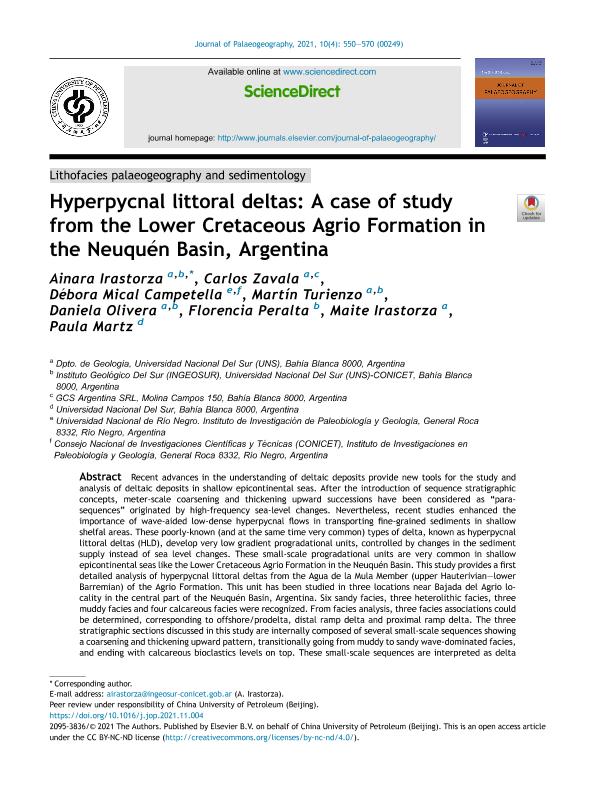Artículo
Hyperpycnal littoral deltas: a case of study from the Lower Cretaceous Agrio Formation in the Neuquén Basin, Argentina
Irastorza, Ainara ; Perez Zavala, Carlos Eduardo; Campetella, Débora Mical
; Perez Zavala, Carlos Eduardo; Campetella, Débora Mical ; Turienzo, Martin Miguel
; Turienzo, Martin Miguel ; Olivera, Daniela Elizabeth
; Olivera, Daniela Elizabeth ; Peralta, Maria Florencia
; Peralta, Maria Florencia ; Irastorza, Maite; Martz, Paula Anabela
; Irastorza, Maite; Martz, Paula Anabela
 ; Perez Zavala, Carlos Eduardo; Campetella, Débora Mical
; Perez Zavala, Carlos Eduardo; Campetella, Débora Mical ; Turienzo, Martin Miguel
; Turienzo, Martin Miguel ; Olivera, Daniela Elizabeth
; Olivera, Daniela Elizabeth ; Peralta, Maria Florencia
; Peralta, Maria Florencia ; Irastorza, Maite; Martz, Paula Anabela
; Irastorza, Maite; Martz, Paula Anabela
Fecha de publicación:
13/11/2021
Editorial:
Elsevier
Revista:
Journal of Palaeogeography
ISSN:
2095-3836
Idioma:
Inglés
Tipo de recurso:
Artículo publicado
Clasificación temática:
Resumen
Recent advances in the understanding of deltaic deposits provide new tools for the study and analysis of deltaic deposits in shallow epicontinental seas. After the introduction of sequence stratigraphic concepts, meter-scale coarsening and thickening upward successions have been considered as ?parasequences? originated by high-frequency sea-level changes. Nevertheless, recent studies enhanced the importance of wave-aided low-dense hyperpycnal flows in transporting fine-grained sediments in shallow shelfal areas. These poorly-known (and at the same time very common) types of delta, known as hyperpycnal littoral deltas (HLD), develop very low gradient progradational units, controlled by changes in the sediment supply instead of sea level changes. These small-scale progradational units are very common in shallow epicontinental seas like the Lower Cretaceous Agrio Formation in the Neuquén Basin. This study provides a first detailed analysis of hyperpycnal littoral deltas from the Agua de la Mula Member (upper Hauterivian?lower Barremian) of the Agrio Formation. This unit has been studied in three locations near Bajada del Agrio locality in the central part of the Neuquén Basin, Argentina. Six sandy facies, three heterolithic facies, three muddy facies and four calcareous facies were recognized. From facies analysis, three facies associations could be determined, corresponding to offshore/prodelta, distal ramp delta and proximal ramp delta. The three stratigraphic sections discussed in this study are internally composed of several small-scale sequences showing a coarsening and thickening upward pattern, transitionally going from muddy to sandy wave-dominated facies, and ending with calcareous bioclastics levels on top. These small-scale sequences are interpreted as delta front deposits of wave-influenced hyperpycnal littoral deltas, punctuated by calcareous intervals accumulated during periods of low sediment supply. It is interpreted that the development of hyperpycnal littoral deltas could have been facilitated by a decrease in sea water salinity related to an increasing runoff.
Archivos asociados
Licencia
Identificadores
Colecciones
Articulos(INGEOSUR)
Articulos de INST.GEOLOGICO DEL SUR
Articulos de INST.GEOLOGICO DEL SUR
Citación
Irastorza, Ainara; Perez Zavala, Carlos Eduardo; Campetella, Débora Mical; Turienzo, Martin Miguel; Olivera, Daniela Elizabeth; et al.; Hyperpycnal littoral deltas: a case of study from the Lower Cretaceous Agrio Formation in the Neuquén Basin, Argentina; Elsevier; Journal of Palaeogeography; 10; 4; 13-11-2021; 550-570
Compartir



